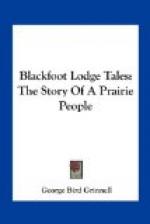The Blackfoot country is especially favored by the warm chinook winds, which insure mild winters with but little snow; and although on the plains there is usually little rain in summer, the short prairie grasses are sweet and rich. All over this vast domain, the buffalo were found in countless herds. Elk, deer, antelope, mountain sheep, and bear without number were there. In those days, sheep were to be found on every ridge, and along the rough bad lands far from the mountains. Now, except a few in the “breaks” of the Missouri, they occur only on the highest and most inaccessible mountains, along with the white goats, which, although pre-eminently mountain animals, were in early days sometimes found far out on the prairie.
BUFFALO
The Blackfeet were a race of meat-eaters, and, while they killed large quantities of other game, they still depended for subsistence on the buffalo. This animal provided them with almost all that they needed in the way of food, clothing, and shelter, and when they had an abundance of the buffalo they lived in comfort.
Almost every part of the beast was utilized. The skin, dressed with the hair on, protected them from the winter’s cold; freed from the hair, it was used for a summer sheet or blanket, for moccasins, leggings, shirts, and women’s dresses. The tanned cowskins made their lodges, the warmest and most comfortable portable shelters ever devised. From the rawhide, the hair having been shaved off, were made parfleches, or trunks, in which to pack small articles. The tough, thick hide of the bull’s neck, spread out and allowed to shrink smooth, made a shield for war which would stop an arrow, and turn a lance thrust or the ball from an old-fashioned, smooth-bore gun. The green hide served as a kettle, in which to boil meat. The skin of the hind leg, cut off above the pastern and again some distance above the hock, was sometimes used as a moccasin or boot, the lower opening being sewed up for the toe. A variety of small articles, such as cradles, gun covers, whips, mittens, quivers, bow cases, knife-sheaths, etc., were made from the hide. Braided strands of hide furnished them with ropes and lines. The hair was used to stuff cushions and, later, saddles, and parts of the long black flowing beard to ornament wearing apparel and implements of war, such as shields and quivers. The horns gave them spoons and ladles—sometimes used as small dishes—and ornamented their war bonnets. From the hoofs they made a glue, which they used in fastening the heads and feathers on their arrows, and the sinew backs on their bows. The sinews which lie along the back and on the belly were used as thread and string, and as backing for bows to give them elasticity and strength. From the ribs were made scrapers used in dressing hides, and runners for small sledges drawn by dogs; and they were employed by the children in coasting down hill on snow or ice. The shoulder-blades, lashed to a wooden handle, formed axes, hoes, and fleshers. From the cannon bones (metatarsals and metacarpals) were made scrapers for dressing hides. The skin of the tail, fitted on a stick, was used as a fly brush. These are but a few of the uses to which the product of the buffalo was put. As has been said, almost every part of the flesh was eaten.




